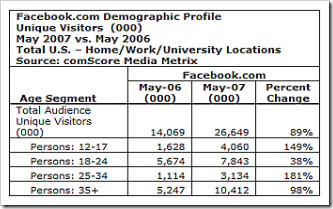 Watching the explosion of content, and users, at Facebook, may be the most interesting thing we've seen since the rise of the commercial Web in 1995/1996. Marc Andreessen, not know for hyperbole, had this to say in a lengthy blog posting (here) that should be required reading for all content providers, including banks and credit unions:
Watching the explosion of content, and users, at Facebook, may be the most interesting thing we've seen since the rise of the commercial Web in 1995/1996. Marc Andreessen, not know for hyperbole, had this to say in a lengthy blog posting (here) that should be required reading for all content providers, including banks and credit unions:
(Facebook Platform) is an amazing achievement — one of the most significant milestones in the technology industry in this decade.
Every time we head over to the Facebook application directory, there's an interesting new financial app. Friday we found ChipIn, a nifty little widget that allows users to post a badge on their Facebook page or website that allows users to contribute money for a certain event or cause. It can be a charitable event such as Vancity's Bike Share program or a private event such as pooling funds for someone's birthday party. ChipIn is the second developer to launch on Facebook using PayPal's engine. The first was PayMe (see our coverage here).
ChipIn <chipin.com> is a Honolulu-based firm formed in mid-2005 with seed funding from CommerceNet. The company emerged from stealth mode in Feb. 2006 and launched its service on the Web in November 2006. The Facebook app launched June 24 and has 415 downloads as of 9 AM this morning, impressive growth compared to the 134 it had on Friday.
Initially, ChipIn was a full-service payments company, actually holding and managing the funds for users. However, after a few months of those headaches, it outsourced all payments-related functions to PayPal. Check out the Chipin blog for the full company history.
How it Works
 ChipIn uses the PayPal engine to do the heavy lifting similar to PayMe that we wrote about two weeks ago (here) (see note 1). To create a ChipIn badge on Facebook, users select a Facebook event (created separately within the social network), set the fundraising goal, then customize the text and colors of the widget.
ChipIn uses the PayPal engine to do the heavy lifting similar to PayMe that we wrote about two weeks ago (here) (see note 1). To create a ChipIn badge on Facebook, users select a Facebook event (created separately within the social network), set the fundraising goal, then customize the text and colors of the widget.
In our test, we created a ChipIn badge with the goal of raising $100 to donate to Vancity's Bike Share program (see screenshot #1 below). Although, we were able to successfully install the widget on our Netbanker Facebook page (see screenshot #3 below), we had trouble with the customization. Every time we moved from the customization step to installation, our changes were lost (note 2).
To use the widget, visitors click on the "chip in" button to launch a PayPal window. Users choose an amount to pay, then login to PayPal, to complete the transaction. A progress bar on the Chipin widget shows the progress towards the fundraising goal.
With a single click the badge can be placed within an individual's Facebook page (see screenshot #2 below). ChipIn also provides cut-and-paste code to load the badge on any blog or website. ChipIn badges can also be built directly through its website without the need for a Facebook account.
Financial Institution Opportunities
PayMe and Chipin are cool little apps that can and should be sponsored by banks, credit unions, or card issuers. Although the PayPal brand name makes Chipin relatively trustworthy, a widely recognized financial brand would be even better. At this point, ChipIn is still a tiny, relatively unknown company. If I were at a major bank, I'd write them a $50,000 check and have them rename their Facebook app, "Chipin by YourBank," instantly becoming the first bank with an official Facebook app. The company will also build white label versions you could provide to customers for use outside Facebook.
For more on how to use social networking in financial services, see our Online Banking Report on Social Personal Finance.
Screenshots
1. Simple ChipIn Widget Creation
Using an existing Facebook account and an existing Facebook event, in this case Vancity's Bike Share (thanks to William Azaroff), a new widget can be created and posted to your Facebook profile in about a minute.

2. Facebook Promotion
Once the badge has been created, the Facebook integration provides simple ways to promote the cause. You can invite up to 10 friends each day, post it on your Facebook profile, or cut and paste the code onto your own website or blog. But the key to viral growth is the Facebook mini-feed which automatically notifies all your friends about any Facebook activities, including the addition of the Chipin badge to your profile.

Posted on the NetBanker Facebook Page
Here's how the ChipIn badge looks on my Facebook profile page (here). Note, you'll need to be logged in to Facebook to view.

Notes:
1. PayPal is not the developer of Chipin, nor do they have any financial interest in the company. Chipin is an independent developer using PayPal APIs.
2. Tests conducted on July 5 using Firefox 2.0.
![]() Four months ago (here) I wrote about how easy it was to set up a company page in Facebook. Even a total novice like myself could create one in a few minutes.
Four months ago (here) I wrote about how easy it was to set up a company page in Facebook. Even a total novice like myself could create one in a few minutes. 





































